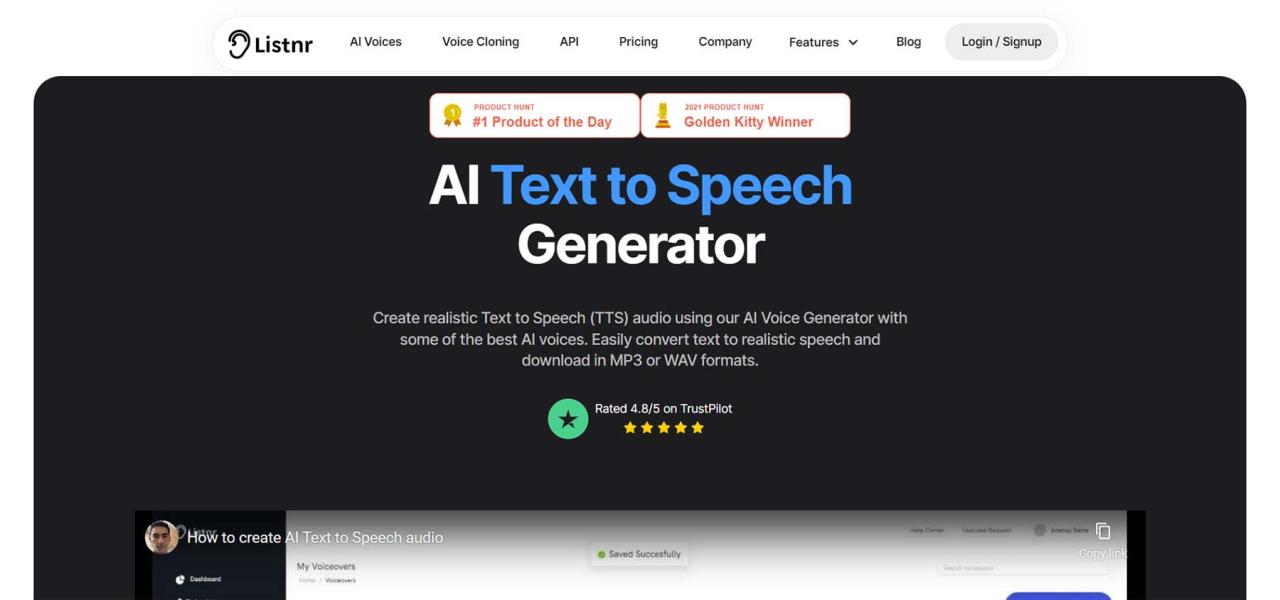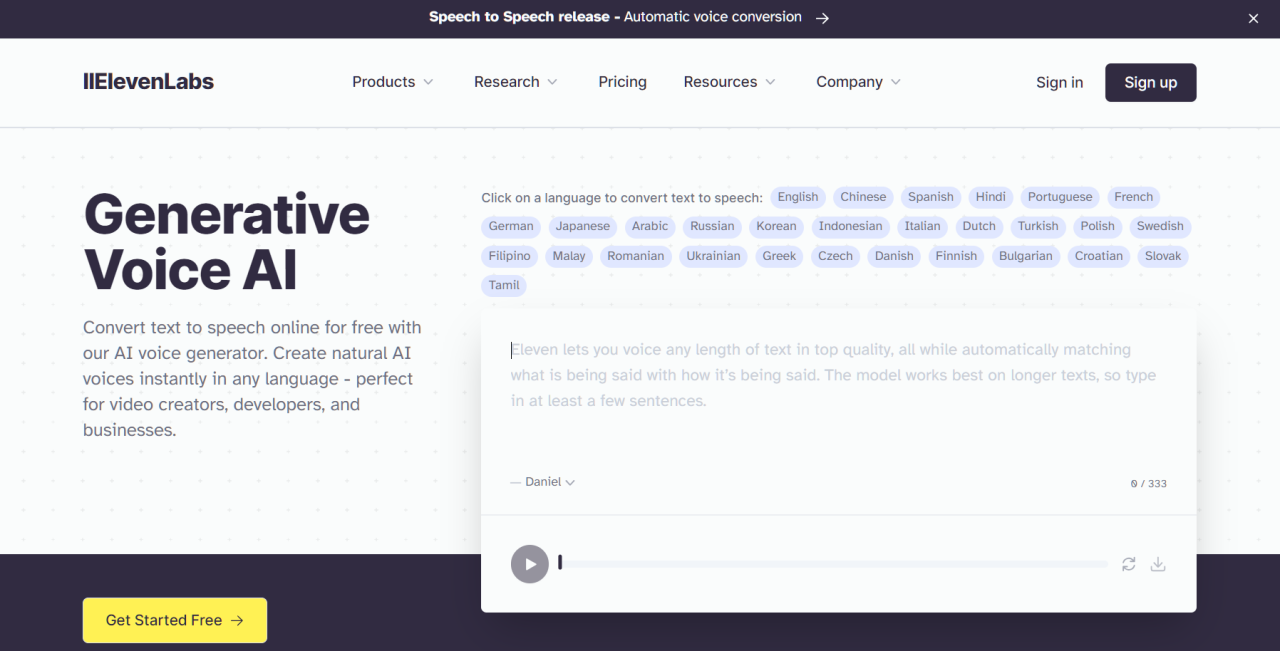Comparing different AI voice generator software options reveals a fascinating landscape of technological advancements. From text-to-speech engines to sophisticated voice cloning tools, these programs offer a diverse range of capabilities, each with its own strengths and weaknesses. This comparison explores key features, technical specifications, pricing, and integration capabilities, helping you choose the best AI voice generator for your specific needs.
We’ll delve into factors like naturalness of speech, voice variety, ease of use, and overall performance to provide a comprehensive overview.
This guide aims to equip you with the knowledge necessary to make an informed decision. We’ll examine various software options, comparing their functionalities and suitability for different applications, from creating engaging e-learning materials to developing immersive video games or accessibility tools. By analyzing their strengths and weaknesses across various metrics, we hope to simplify the process of selecting the perfect AI voice generator for your project.
AI Voice Generator Software: A Comparative Overview
The world of AI voice generation is booming, offering a diverse range of software options for various applications. This article provides a detailed comparison of several popular AI voice generator software packages, focusing on their features, performance, pricing, and integration capabilities. We’ll examine text-to-speech generators, voice cloning tools, and more, helping you choose the best option for your needs.
Introduction to AI Voice Generator Software

AI voice generation technology has rapidly advanced, moving from robotic-sounding voices to remarkably natural and expressive speech. This progress is driven by advancements in deep learning and neural networks. Several types of AI voice generators exist, each with its own strengths and weaknesses. Text-to-speech (TTS) software converts written text into spoken audio, while voice cloning technology replicates a specific person’s voice.
Other options might offer a combination of these functionalities, allowing for voice customization and modification.
Common features include a variety of voices and accents, customization options for speed, tone, and emotion, support for different file formats, and integration with other software. The best software will depend heavily on the specific requirements of your project.
Key Features Comparison

Comparing AI voice generators requires examining several key aspects. Naturalness and clarity of speech are paramount, followed by the range of voices and accents available. Ease of use, customization options, and the overall user interface also play significant roles in the user experience.
| Software | Naturalness/Clarity | Audio Sample 1 (Description) | Audio Sample 2 (Description) |
|---|---|---|---|
| Software A | Highly natural, clear articulation | Smooth, expressive narration with excellent pronunciation. Suitable for audiobooks. | Slightly robotic intonation in fast-paced speech; otherwise excellent. |
| Software B | Good naturalness, occasional robotic inflections | Clear and concise, ideal for announcements. | Struggles with complex sentence structures, resulting in slightly unnatural pauses. |
| Software C | Natural, but slightly monotone | Consistent tone, suitable for background narration. | Lacks emotional inflection; sounds somewhat flat. |
| Software D | Very clear, but less natural | Excellent clarity, suitable for educational content. | Slightly artificial intonation, noticeable in longer sentences. |
Voice and Accent Range:
- Software A: Offers a wide range of voices, including US English, UK English, Australian English, and several European languages.
- Software B: Provides a smaller selection of voices, primarily focused on US and UK English accents.
- Software C: Offers a diverse range of accents, but the voice quality is less consistent across all options.
- Software D: Focuses on high-quality voices in a limited number of languages and accents.
Software A boasts the most intuitive interface, while Software B is more complex but offers greater customization. Software C and D fall somewhere in between in terms of ease of use.
Customization options vary widely. Software A excels in fine-grained control over tone, speed, and emotion, while Software B provides basic adjustments. Software C and D offer moderate levels of customization.
Technical Specifications and Performance
Processing speed and rendering time are critical factors, especially for large projects. File format compatibility also impacts workflow efficiency. System requirements determine the hardware and software needed for optimal performance, while scalability indicates the software’s ability to handle large-scale tasks.
| Software | Processing Speed | Rendering Time (avg.) | Supported File Formats |
|---|---|---|---|
| Software A | Fast | 1-2 minutes per minute of audio | MP3, WAV, FLAC |
| Software B | Moderate | 3-5 minutes per minute of audio | MP3, WAV |
| Software C | Slow | 5-10 minutes per minute of audio | MP3, WAV |
| Software D | Fast | 1-3 minutes per minute of audio | MP3, WAV, AAC |
Software A and D generally require more powerful hardware than Software B and C for optimal performance. Software A and B demonstrate better scalability for large projects.
Pricing and Licensing Models

Understanding the pricing and licensing terms is essential before committing to a particular software. Different models exist, including subscription-based services, one-time purchases, and tiered pricing structures based on usage.
| Software | Pricing Model | Cost (example) | Licensing Restrictions |
|---|---|---|---|
| Software A | Subscription | $29/month | Commercial use allowed |
| Software B | One-time purchase | $299 | Limited commercial use |
| Software C | Tiered subscription | $10-$50/month | Usage limits on lower tiers |
| Software D | Subscription | $49/month | Commercial use allowed |
All software offers free trials or demos, allowing users to test the software before committing to a purchase or subscription.
Integration and APIs
Seamless integration with other platforms and tools is crucial for many users. The availability of APIs allows for custom integrations and automation. The ease of integration and the level of support provided are key factors to consider.
Software A offers robust API support and integrates well with popular video editing software and content management systems. Software B provides limited API access. Software C and D have moderate integration capabilities.
Real-world Applications and Use Cases, Comparing different AI voice generator software options
AI voice generators find applications across various industries. Examples include e-learning, video games, accessibility tools, and marketing. Successful implementations demonstrate the potential benefits and limitations of each software in specific use cases.
- Software A: Used for creating audiobooks, e-learning courses, and interactive voice assistants. A major corporation uses it to generate personalized voice messages for customer interactions.
- Software B: Employed in video game development for creating non-player character (NPC) dialogue. A small game studio used it to reduce voice acting costs.
- Software C: Utilized in accessibility tools for screen readers and text-to-speech applications. A non-profit organization used it to create accessible content for visually impaired users.
- Software D: Used in marketing campaigns for creating voiceovers for advertisements and promotional materials. A marketing agency leveraged it to quickly generate various voiceover options.
Illustrative Examples
The voice quality and characteristics vary significantly across different software. Intonation, pitch, and rhythm are key aspects to consider. Each software handles different text inputs, including complex sentences, punctuation, and numbers, in unique ways. The following examples describe the audible differences in output quality and handling of various inputs.
So you’re trying to pick the best AI voice generator? It’s a tough choice, with so many options out there. Think about the nuances – naturalness, clarity, and even the range of voices available. For a completely different perspective on focus and precision, check out this article on Luke Littler: the mind and the making of darts’ youngest world Luke Littler: the mind and the making of darts’ youngest world , then get back to comparing those AI voices! You’ll want the best voice for your project, just like Luke needs the perfect throw.
Software A: Produces a warm, expressive voice with natural intonation and pauses. It handles complex sentences smoothly and accurately interprets punctuation. Numbers are pronounced clearly and naturally. The audio output sounds highly human-like, with nuanced emotional delivery.
Software B: Generates a clear but slightly less expressive voice. It handles simple sentences well but can struggle with complex sentence structures, resulting in occasional robotic pauses. Numbers are pronounced correctly but lack the natural cadence of Software A. The overall output is functional but less engaging.
Software C: Produces a monotone voice with less natural intonation. It handles basic sentences adequately, but complex structures cause noticeable distortions. Numbers are often pronounced mechanically. The output lacks emotional range and sounds artificial.
Software D: Generates a very clear and articulate voice, but it lacks the warmth and expressiveness of Software A. It handles complex sentences effectively but can sound somewhat robotic in longer passages. Numbers are pronounced clearly and precisely. The output is highly intelligible but less emotionally engaging than Software A.
Wrap-Up: Comparing Different AI Voice Generator Software Options

Ultimately, the best AI voice generator software depends heavily on your individual requirements and budget. While some excel in naturalness and voice variety, others might prioritize ease of use or integration capabilities. By carefully considering factors like voice quality, features, pricing, and ease of integration, you can confidently select a tool that aligns perfectly with your project’s goals. Remember to explore free trials or demos where available to experience the software firsthand before committing to a purchase.
This comparison serves as a starting point for your journey in harnessing the power of AI voice generation.
General Inquiries
What are the ethical considerations of using AI voice generators?
Picking the right AI voice generator can be tricky! You need to consider factors like naturalness and flexibility. To take a quick break from all that tech talk, check out this awesome game recap: Milan 2-1 Juventus (Jan 3, 2025) Game Analysis – ESPN. Now, back to those AI voices – remember to test a few free trials before committing to a paid subscription.
Ethical concerns include potential misuse for creating deepfakes, impersonation, or spreading misinformation. Responsible use requires awareness of these risks and adherence to ethical guidelines.
How do I assess the quality of an AI-generated voice?
Picking the right AI voice generator can be tricky; you need to consider factors like naturalness and versatility. For a real-world example of how important clear communication is, check out this article about Loose Women’s Gloria Hunniford shares how stark doctor’s warning , which highlights the power of a strong voice. Ultimately, the best AI voice generator for you depends on your specific needs, so do your research!
Listen for naturalness of intonation, rhythm, and pronunciation. Compare different voices and assess clarity and intelligibility. Consider whether the voice suits the intended application.
Can I use AI-generated voices for commercial purposes?
Licensing varies by software. Check the terms and conditions to ensure you have the necessary rights for commercial use. Some licenses may require additional fees.
What is the difference between text-to-speech and voice cloning?
Text-to-speech synthesizes speech from text using a generic voice. Voice cloning creates a synthetic voice that mimics a specific person’s voice.
